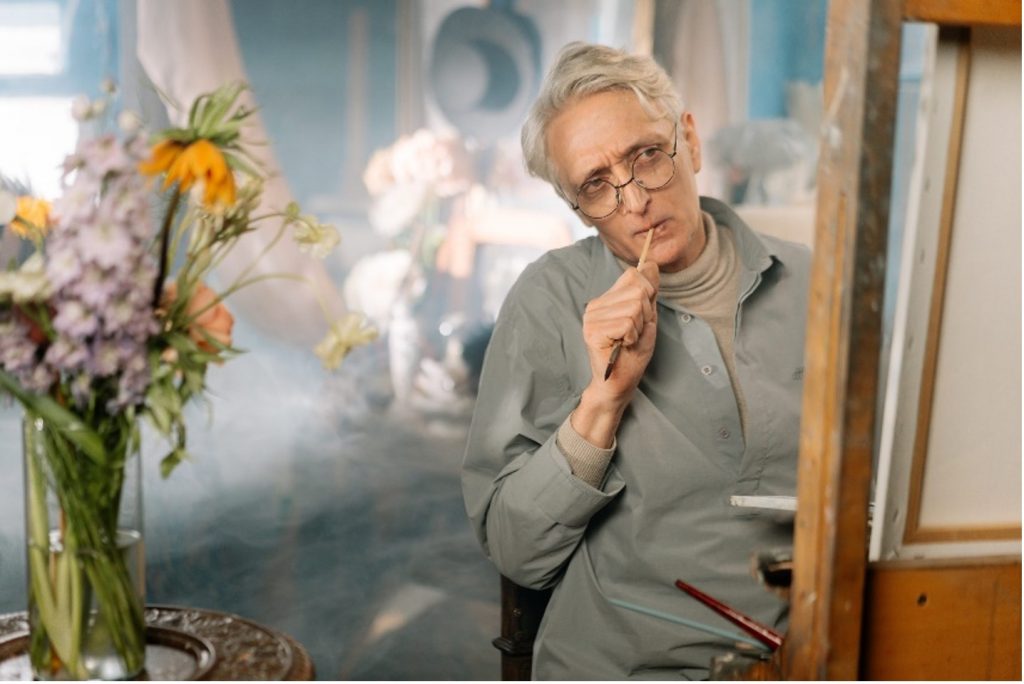Not every piece of artwork sells. This can be tough and disappointing for an artist. However, finding a way to make the best of the situation when the artwork doesn’t sell is crucial. And by taking a proactive approach, you can turn what may seem like a disappointment into a new opportunity. That’s why we’re here to help. Let’s explore this crucial topic that can help you keep your momentum going and even elevate your career.

1. Reevaluate the artwork
Evaluating unsold artwork is a crucial step for artists to understand why their work may not be getting the recognition they desire. Therefore, it’s important to take a closer look and identify potential drawbacks or improvement areas. And being completely honest about the strengths and weaknesses of your artwork is essential.
To best evaluate unsold artwork, try to view it from a buyer’s perspective:
- Would you buy this artwork?
- Would you pay the price you’re putting it as?
- Does the artwork convey a message or elicit an emotional response?
- Does the artwork have a unique or distinctive quality that sets it apart from similar works?
Understanding your artwork can help you make informed decisions about what changes to make. This process may be challenging, but it can ultimately help you improve your craft and make your artwork more marketable. So, don’t be afraid to take a step back and reevaluate your work – it could lead to great opportunities.
2. Offer the artwork to other venues
If your artwork isn’t selling, don’t get discouraged. Sometimes the first try doesn’t work, and that’s okay. Diversifying the places where you offer your artwork for sale can increase the chances of finding buyers and provide you with more things to do with unsold artwork. Consider reaching out to different venues such as galleries, art fairs, or online marketplaces to showcase your unsold artwork. Before approaching these venues, it’s essential to do your research and find the ones that fit your style and target audience.
When presenting your artwork to potential buyers, create an attractive portfolio or display that showcases your work in the best possible light. By presenting your artwork professionally and targeting the right venues, you can increase your chances of finding buyers and selling your unsold pieces. Remember, every artist faces challenges in selling their artwork, but with persistence and creativity, you can find new opportunities to share your art with the world.

3. Repackage the artwork
Repackaging unsold artwork can be an excellent way to give your artwork a fresh perspective and potentially make it more appealing to buyers. Repackaging can be as simple as changing the framing or display method or as complex as creating a completely new artwork by combining multiple pieces. Another option is for you to consider grouping similar pieces together or offer them as part of a limited-edition series.
To market repackaged artwork, consider using social media to showcase the new presentation and generate buzz. Creating a newsletter or email campaign can also be an effective way to reach potential buyers and showcase your repackaged artwork. Alternatively, consider hiring an art agent who can help you repackage and market your unsold artwork effectively. With a little creativity and strategic thinking, repackaging unsold artwork can be a great way to breathe new life into your work and increase your chances of making a sale. Don’t be afraid to experiment and try new things – you never know what might work until you give it a try!
4. Store it for the future
Sometimes, artwork doesn’t sell because it’s ahead of its time or just not the right fit for the current market. It’s okay and storing it away for the future can be a smart move.
However, it’s important to store your unsold artwork properly. This way, you’ll ensure they remain in good condition and are ready for future opportunities. After all, imagine the frustration of removing your unsold artwork from storage to sell it, only to discover that it was damaged due to improper storage. Therefore, some simple steps to avoid many issues are using acid-free materials and avoiding direct sunlight or extreme temperatures. It’s also a good idea to keep an inventory of stored artwork and label each piece to make it easy to find in the future. If storage space is limited, consider renting a storage unit to keep the artwork safe and secure. By storing unsold artwork properly, artists can ensure their work is ready for future exhibitions or opportunities.

5. Donate the artwork
By donating artwork to a non-profit organization or charity, artists can support a cause they believe in while also generating goodwill and potential recognition. When donating artwork, it’s essential to choose the right organization that aligns with your values and mission. Research potential organizations and their goals to ensure that your artwork will be used in a way that you are comfortable with.
Some organizations that accept artwork donations include:
- Hospitals and medical facilities
- Schools and educational programs
- Museums and art institutions
- Charity auctions and events
Donating unsold artwork is a great way to give your art a home and support a worthy cause. Plus, it’s one of the many things to do with unsold artwork that can help artists positively impact their community.
6. Repurpose the materials
Sometimes, despite an artist’s best efforts, certain pieces of artwork simply don’t sell. In these cases, repurposing the materials used in the artwork can be a way to breathe new life into the pieces and make something new and valuable. Furthermore, it helps reduce waste. However, it’s important to note that this should only be considered as a final resort if the artist truly believes the piece is no longer of value. To safely repurpose the materials, artists can carefully deconstruct the piece and reuse the materials in a new project. For example, the canvas from an unsold painting could be a base for a new piece.
Conclusion
In conclusion, there are many things to do with unsold artwork. From repackaging artwork to repurposing the materials, artists have a variety of strategies to explore. It’s important to try different approaches and not give up on your artwork. Remember that unsold artwork doesn’t mean failure; there are always new opportunities to showcase your work. So keep creating, keep pushing boundaries, and keep believing in your artistic vision.
_______________________________
Author bio:
Meet Samantha Davis; a teacher turned blogger. She is an avid traveler and writer who currently works as a consultant for Beltway Movers. Her love of travel has taken her to various art galleries and exhibitions around the world, inspiring her passion for art. She now writes about it any chance she gets. Through her writing, Samantha hopes to share her love of art with others and inspire them to explore its beauty and creativity.


